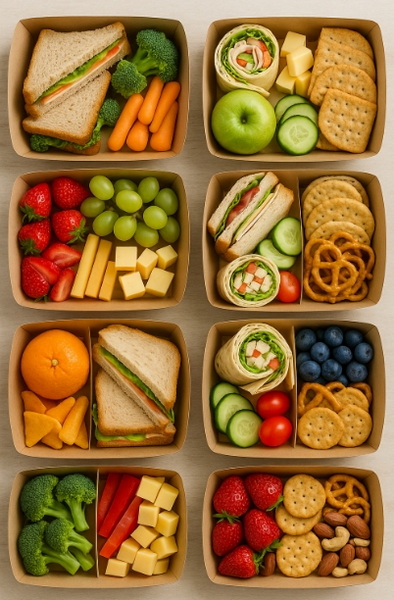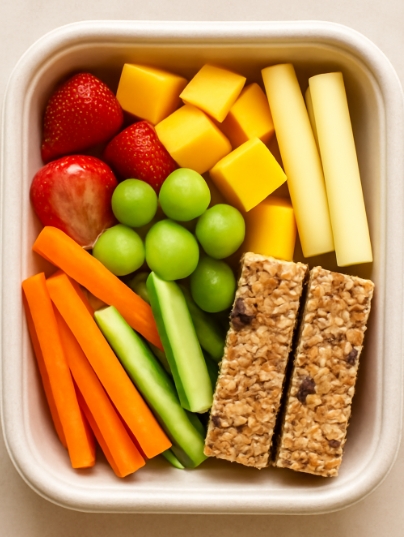
Content Menu
● Understanding Disposable Lunch Boxes
● Key Considerations for Packing Food in Disposable Lunch Boxes
>> Temperature Control
>> Moisture Management
>> Portion and Packaging
>> Allergy Awareness
● Best Types of Food for Disposable Lunch Boxes
>> Sandwiches and Wraps
>> Fruits and Vegetables
>> Dairy and Protein Snacks
>> Grains and Baked Goods
>> Packaged and Shelf-Stable Snacks
>> Creative Lunch Box Ideas
● Tips for Packing Disposable Lunch Boxes
● Foods to Avoid in Disposable Lunch Boxes
● Advanced Packing Strategies for Disposable Lunch Boxes
>> Layering for Freshness
>> Portion Control and Balanced Nutrition
>> Themed Lunch Boxes
>> Food Safety Tips
● Eco-Friendly and Sustainable Disposable Lunch Boxes
● Conclusion
● Frequently Asked Questions (FAQ)
>> 1. What are the best protein options for disposable lunch boxes?
>> 2. How can I keep food fresh in a disposable lunch box without refrigeration?
>> 3. Are disposable lunch boxes environmentally friendly?
>> 4. What snacks are best for kids in disposable lunch boxes?
>> 5. Can I pack hot foods in disposable lunch boxes?
Packing a lunch is a daily ritual for many people, whether for work, school, travel, or outdoor activities. In today's fast-paced world, disposable lunch boxes have become a go-to solution for their convenience, portability, and ease of cleanup. However, not all foods are equally suited for disposable lunch box meals. Selecting the right foods ensures your lunch stays fresh, appetizing, and safe to eat, even hours after packing.
This comprehensive guide will explore the best types of food for disposable lunch boxes, tips for packing, foods to avoid, and answers to common questions. Whether you're a parent, a student, a professional, or someone who loves outdoor adventures, you'll find practical advice to make your food lunch box disposable experience both enjoyable and efficient.

Understanding Disposable Lunch Boxes
Disposable lunch boxes are single-use containers made from materials such as paper, cardboard, plastic, or eco-friendly alternatives like bagasse or bamboo fiber. Their primary appeal is convenience. After use, you can simply discard them, eliminating the need for washing and carrying bulky containers home. This makes them ideal for school field trips, office meetings, picnics, parties, and travel.
However, since disposable lunch boxes are not usually insulated or airtight, the types of food you pack should be chosen with care. The goal is to keep food fresh, safe, and mess-free until it's time to eat.
Key Considerations for Packing Food in Disposable Lunch Boxes
Temperature Control
Most disposable lunch boxes do not offer insulation. Foods that are safe at room temperature or do not require refrigeration are best. If you must include perishable items, consider using frozen juice boxes or ice packs, but be aware that these options are limited in how long they can keep food cold.
Moisture Management
Moisture can be the enemy of a successful food lunch box disposable meal. Foods with high water content or sauces can make other items soggy or cause leaks. Use separate containers or wrap items tightly to keep dry and wet ingredients apart.
Portion and Packaging
Pre-portioned snacks and single servings fit best in disposable lunch boxes. Compact packaging helps maximize space and keeps foods from mixing. Consider using small, disposable cups or bags for dips, dressings, and snacks.
Allergy Awareness
If you're preparing food lunch box disposable meals for a group, be mindful of common allergens. Clearly label foods and consider providing alternatives for those with dietary restrictions.
Best Types of Food for Disposable Lunch Boxes
Sandwiches and Wraps
Sandwiches and wraps are classic lunch box staples for a reason. They are easy to assemble, portable, and can be customized for any taste or dietary need.
- Classic Sandwiches: Choose fillings that stay fresh at room temperature, such as nut butters, hard cheeses, cured meats, or roasted vegetables. Avoid mayonnaise or other perishable spreads unless the lunch will be eaten soon after packing.
- Wraps and Pinwheels: Tortilla wraps filled with deli meats, cheese, or grilled vegetables are less likely to get soggy than traditional bread. Slice wraps into pinwheels for a fun, bite-sized option, especially for kids.
Fruits and Vegetables
Fresh produce adds color, nutrition, and crunch to any food lunch box disposable meal.
- Whole Fruits: Apples, oranges, bananas, grapes, and pears are sturdy and travel well. They don't require refrigeration and are less likely to bruise or leak.
- Cut Fruits: Melon, pineapple, strawberries, and blueberries can be packed in small, sealed containers. Consider using fruit cups or applesauce pouches for added convenience.
- Raw Vegetables: Carrot sticks, celery, cucumber slices, cherry tomatoes, and bell pepper strips are great for dipping and snacking. Pair them with single-serve hummus or ranch cups.
Dairy and Protein Snacks
Protein-rich foods keep you full and satisfied throughout the day.
- Cheese: Hard cheeses like cheddar, gouda, or string cheese are less perishable and easy to pack.
- Yogurt: Shelf-stable yogurt tubes or cups are a good option. Freeze them overnight to help them stay cool until lunchtime.
- Eggs and Protein Kits: Hard-boiled eggs, beef jerky, or shelf-stable tuna or chicken salad kits are convenient sources of protein that don't require refrigeration.
Grains and Baked Goods
Grain-based foods are filling and versatile.
- Crackers and Chips: Whole grain crackers, pita chips, and pretzels are perfect for dipping or pairing with cheese.
- Muffins and Bagels: Mini muffins, bagels, or English muffins are easy to pack and can be enjoyed plain or with spreads.
- Tortilla Chips and Salsa: Pack salsa or guacamole in a small disposable cup for dipping.
Packaged and Shelf-Stable Snacks
Packaged snacks are a lifesaver for food lunch box disposable meals, especially when time is short.
- Granola Bars and Trail Mix: These are energy-dense, non-perishable, and easy to pack.
- Dried Fruit and Fruit Leather: Raisins, dried apricots, or fruit leather provide natural sweetness without spoilage.
- Single-Serve Cups: Applesauce, fruit cups, or pudding cups are convenient and mess-free.
Creative Lunch Box Ideas
- DIY Lunch Kits: Create your own “lunchable” by packing meat, cheese, and crackers separately.
- Mini Calzones or Pizza Rolls: These can be eaten cold and are less messy than traditional pizza.
- Breakfast-for-Lunch: Pancakes, waffles, or mini quiches offer variety and can be enjoyed at room temperature.

Tips for Packing Disposable Lunch Boxes
- Separate Wet and Dry Foods: Use disposable cups or bags to keep wet foods from making dry foods soggy.
- Seal Tightly: Use zip-top bags or lidded snack cups to prevent leaks and spills.
- Freeze Drinks: Frozen water bottles or juice boxes can keep food cool and serve as a refreshing drink by lunchtime.
- Label Everything: Especially for group events, labeling helps avoid mix-ups and manage allergies.
- Choose Eco-Friendly Options: Opt for compostable or recyclable disposable lunch boxes to reduce waste.
Foods to Avoid in Disposable Lunch Boxes
Some foods are best left out of a food lunch box disposable meal due to safety or mess concerns:
- Highly Perishable Items: Foods like fresh dairy, eggs, or seafood that require constant refrigeration are risky unless eaten soon after packing.
- Messy or Leaky Foods: Soups, stews, or foods with a lot of sauce can leak and ruin other items.
- Strong Odors: Foods with strong smells may be unappealing, especially in shared spaces.
Advanced Packing Strategies for Disposable Lunch Boxes
Layering for Freshness
When packing a food lunch box disposable meal, consider layering ingredients to maintain freshness. For example, place lettuce or greens between bread and moist fillings to prevent sogginess. Use wax paper or parchment to separate items that might stick together.
Portion Control and Balanced Nutrition
A well-balanced lunch includes protein, grains, fruits, vegetables, and a small treat. Use small containers or portioned bags to control serving sizes and ensure a variety of nutrients.
Themed Lunch Boxes
Make lunchtime more exciting by creating themed food lunch box disposable meals. Some ideas include:
- Mediterranean Lunch Box: Hummus, pita chips, olives, cherry tomatoes, cucumber slices, and a small piece of baklava.
- Mexican-Inspired Lunch Box: Tortilla chips, salsa, black bean salad, cheese cubes, and a clementine.
- Breakfast-for-Lunch Box: Mini pancakes, hard-boiled egg, apple slices, and a yogurt tube.
Food Safety Tips
- Wash Hands and Surfaces: Always wash hands and clean surfaces before preparing food.
- Use Fresh Ingredients: Pack only fresh, high-quality ingredients to minimize spoilage risk.
- Monitor Time: Try to consume the food lunch box disposable meal within four hours of packing, especially if it contains perishable items.
Eco-Friendly and Sustainable Disposable Lunch Boxes
With growing awareness of environmental issues, many people are seeking sustainable alternatives for their food lunch box disposable needs. Options include:
- Compostable Lunch Boxes: Made from plant fibers, these break down naturally after use.
- Recyclable Paper Boxes: Sturdy and biodegradable, these are a better choice than plastic or foam.
- Minimal Packaging: Choose snacks and foods that require little or no additional packaging to reduce waste.
Conclusion
Choosing the right types of food for disposable lunch boxes is key to ensuring meals are safe, tasty, and convenient, whether for school, work, travel, or special events. The best options are non-perishable, easy to eat, and low-mess, including sandwiches, wraps, whole fruits, raw vegetables, cheese, shelf-stable proteins, and packaged snacks. With thoughtful packing, creative ideas, and eco-friendly choices, your food lunch box disposable experience can be both nutritious and enjoyable. No matter where your day takes you, a well-packed disposable lunch box can deliver a satisfying meal with minimal fuss.

Frequently Asked Questions (FAQ)
1. What are the best protein options for disposable lunch boxes?
The best protein options for a food lunch box disposable meal are those that do not require refrigeration and are easy to eat. Examples include hard-boiled eggs, beef jerky, shelf-stable tuna or chicken salad kits, string cheese, and nut butters. These foods provide lasting energy and are safe at room temperature for several hours.
2. How can I keep food fresh in a disposable lunch box without refrigeration?
To keep food fresh, use frozen drinks or ice packs, select naturally shelf-stable foods, and avoid highly perishable items. Wrapping sandwiches and snacks tightly and using sealed containers helps maintain freshness and prevent leaks. Packing the lunch box just before leaving home also helps preserve quality.
3. Are disposable lunch boxes environmentally friendly?
Some disposable lunch boxes are made from compostable or recyclable materials, such as eco-friendly paper or plant-based containers. Choosing these options helps reduce environmental impact compared to traditional plastic or foam containers. Always check local recycling and composting guidelines.
4. What snacks are best for kids in disposable lunch boxes?
Kid-friendly snacks for a food lunch box disposable meal include granola bars, trail mix, fruit leather, applesauce pouches, crackers, string cheese, and cut fruits or vegetables. These items are easy to eat, require minimal preparation, and are less likely to create a mess.
5. Can I pack hot foods in disposable lunch boxes?
Hot foods are not ideal for disposable lunch boxes unless they can be enjoyed at room temperature. If you need to pack hot food, use insulated disposable containers and consume the food within a few hours. Generally, it is safer to stick with foods that are enjoyable cold or at room temperature.

















